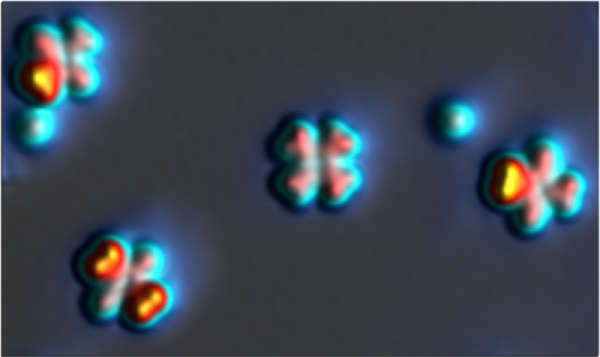Our research activity is focused on the quantum properties of low dimensional systems and hybrid organic/inorganic heterostructures. Combining scanning tunneling microscopy and spectroscopy (STM/STS) with other non-local spectroscopies (XPS/ARPES, XAS/XMCD), we study the correlation between structural, electronic and magnetic properties in order to manipulate them with atomic precision. Our current research activities focus on:

Molecular electronics and magnetism
Ligand chemistry can be a powerful tool to tailor the electronic and magnetic properties of individual atoms, as well as their interactions at the interface with other inorganic materials. The latter is crucial, since the presence of interfacial interactions can strongly perturb the molecular properties, but also induce new charge and spin configurations, hybrid states, or topological phases. Controlling such interactions requires an atomic scale understanding of the correlation between structural, electronic and magnetic properties. In our group we study this correlation of local properties, providing insight in the effect of interactions on the interfacial properties, and examine different manipulation strategies to control them.

Graphene nanoarchitectonics
The remarkable electron and heat conductivity, mechanical stiffness, or impermeability has conferred graphene the title of “the wonder material”. Yet, many properties that are relevant for a variety of applications are still missing in this single layer of carbon, namely the semiconducting gap that is essential in (opto)electronics and photonics, the magnetic moments that could be exploited in spintronic devices, or the selective permeability and reactivity that is needed for nanofiltration and sensing applications respectively. This missing properties can be introduced in graphene by means of nanostructuration and functionalization. In our group we employ different bottom-up strategies for the realization of graphene nanoarchitectures where the structure and chemical composition are tailored with atomic precision.

Manipulating electrons with step superlattices
Materials with strong correlations between charge, spin, orbital, topological and lattice degrees of freedom can exhibit exotic quantum phenomena that has inspired a new generation of devices for computing, communication, energy harvesting or sensing. As for any other material in the past, their successful technological application depends on two factors: a fundamental understanding of the emerging phenomena, and the capability to engineer and tune their key properties. Our group faces this two-fold challenge by exposing electrons to superlattice potentials created by surface atomic steps. A fundamental insight of the interaction of electrons with the step potentials is also obtained by studying electron scattering at individual steps by STM.
